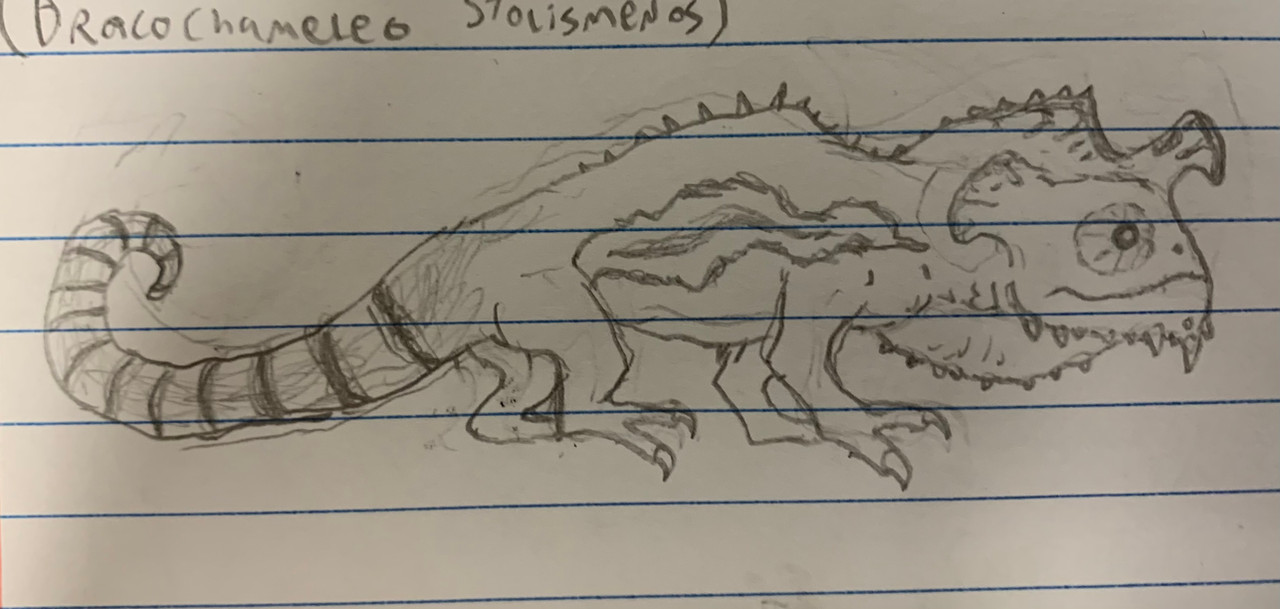HOME | DD
 Throngmar — Dragon Chameleon
Throngmar — Dragon Chameleon

#dragon #florida #islandgigantism #exocene #morderon #caribbean #chameleon #crocodile #megafauna #pencildrawing #speculativeevolution #arapang
Published: 2021-02-01 02:59:49 +0000 UTC; Views: 2771; Favourites: 25; Downloads: 0
Redirect to original
Description
Dragon Chameleon
Scientific name: Dracochameleo stolismenos
Other names: Crocodile Chameleon, Ornate Chameleon, Caribbean Dragon
Ancestor: Veiled Chameleon
Diet: Medium-sized vertebrates, large vertebrates
Habitat and range: Caribbean islands (Morderon, Arapang, Sotaar, Caarn, Cilix, Fujioka, Rhopoji, Aivroklesh, Plognost, Hraezvelgr, Hispaniola)
Moving from the mainland of North America into the Caribbean islands, we find many wonders. Asides from Hispaniola and Cuba, most of the islands in the archipelago have been shifted, expanded, and shrunken by a combination of earthquakes, volcanoes, and simple plate tectonics that they can no longer truly be considered the same islands. Largest of the islands is Morderon, which was once called Florida in the days when it was connected to the mainland. King Maagrys island, Arapang island, and Klim-wala island are three other large islands formed by tectonic madness. Cuba is now the fifth-largest of the islands, followed by Sotaar and Hispaniola. Because of the volcanic and tectonic events that shuffled these islands, the migrations of animals living there is left in a patchwork, with species a living on island a, species b living on island b and c, species c living on island c and d, species d living on island d, b, and a, and so on.
The Dragon Chameleon is, to put it scientifically, very cool. Descended of the Veiled Chameleons that went feral in Florida, they are the largest carnivorous lizard on the planet, weighing an average of 600 lbs, and between 8 and 13 ft long; that's the size of a goddamn crocodile. And unlike crocodiles, they are completely terrestrial. They are ambush predators, waiting in thick brush and foliage for large prey to walk by (between the size of a rabbit and a sheep), and then they jettison their crazy chameleon-tongue at the prey. Because of size and weight mechanics, they are unable to grasp prey with their tongues; it isn't strong enough, and the prey is usually too heavy. Instead, they basically use their tongue as a gun, punching their prey with a quick shot, and a shock so powerful that it kills smaller prey instantly and maims or stuns larger prey. When the prey is incapacitated, it is food time. While all individuals have an ornate head-crest and dewlap, it is heavily pronounced on the males (as seen above), and is used to inform females that they are cultured and fancy. During the year, their colors are rather muted, staying within the range of greens and browns while changing for temperature regulation. However, during breeding season, the colors go bonkers. Pink, yellow, orange, neon green, red with cyan stripes, purple flecked with golden-yellow and lined with jade; nothing is off the table. Additional, they are on the more clever end of the reptile-intelligence spectrum.
Related content
Comments: 2

👍: 0 ⏩: 1

👍: 0 ⏩: 0
























